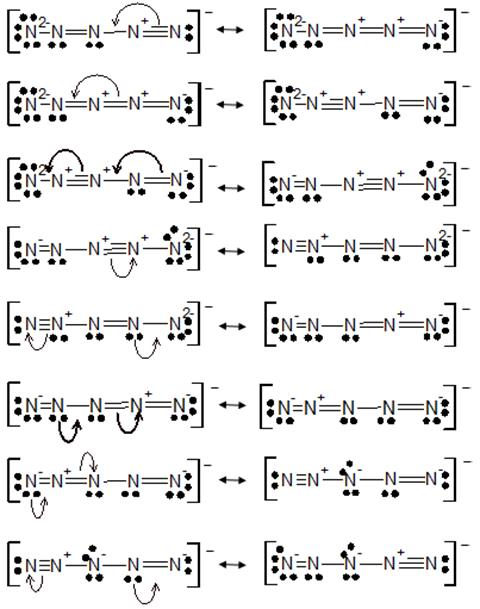
To draw:
a) The Lewis structures for four resonance forms of linear N5-.
b) Calculate formal charges and identify the structures that contribute the most to the bonding in N5-.
c) By comparing Lewis structures for N5- and N3-, find out the ion in which the nitrogen-nitrogen bonds have the higher average bond order.
Answer to Problem 4.175QA
Solution:
a)

b) The last four structures having the lowest formal charge. These structures contribute the most to the bonding in N5-.
c)
![]()
From these resonance structures we see that each bond is predicted to be of double bond character in N3-. Therefore, in N5- there are two longer nitrogen-nitrogen bonds than in N3-. N3- has the higher average bond order.
Explanation of Solution
The ground state electronic configuration of N is 1s2 2s2 2p3.
| Element | Valence electrons | ||
| Symbol | # of atoms | In one atom | Total |
| N | 5 | 5 | 25 |
| One electron from -1 charge | 1 | ||
| Valence electrons in molecule | 26 | ||
Each N atom is attached with single bond.
N - N - N - N - N
Eight electrons get involved in the bond formation. Now we put remaining electrons as lone pairs on the atoms.
![]()
The octet of terminal N atoms is get completed. The octet of remaining N is not get completed. For that we will convert some lone pairs into bond pairs.

Now we calculate the formal charge on each atom in second structure.
The Lewis structure with formal charge on N atom is as follows.

![]()
Now we draw the resonating structures of this molecule.

The molecules which having minimum formal charge will contribute the most to the bonding in N5-. Following structures having least formal charge and will contribute the most to the bonding in N5-.
![]()
![]()
![]()
![]()
Let’s we draw the Lewis structure of N3-.
| Element | Valence electrons | ||
| Symbol | # of atoms | In one atom | Total |
| N | 3 | 5 | 15 |
| One electron from -1 charge | 1 | ||
| Valence electrons in molecule | 16 | ||
![]()
From these resonance structures we see that each bond is predicted to be of double bond character. Therefore, in N5- there are two longer nitrogen-nitrogen bonds than in N3-.
Bond order is the number of bonds between atoms. For single bond the bond order is 1. For double bond the bond order is 2. For triple bond the bond order is 3. From the resonance structure of N5- and N3-, we can say that N3- has the higher average bond order.
Conclusion:
From the electronic configuration of atoms in the molecule we can draw Lewis structure of the molecule. From the Lewis structure we can find out formal charge and bond order.
Want to see more full solutions like this?
Chapter 4 Solutions
Chemistry: An Atoms-Focused Approach
- 4. True or false: This skeletal structure represents a saturated fatty acid. Ini to 0 fale) me OH faistong starrow_forwardBy malonic or acetylacetic synthesis, synthesize 5-Methyl-2-hexanone (with the formulas of the compounds).arrow_forwardQUESTION: Answer Question 5: 'Calculating standard error of regression' by filling in all the empty green boxes *The values are all provided in the first photo attached*arrow_forward
- Draw the formula for 3-chlorobenzoic acetic anhydride.arrow_forwardBy malonic or acetylacetic synthesis, synthesize 2-methylbutanoic acid (indicate the formulas of the compounds).arrow_forwardObtain 2-methylbutanoic acid by malonic or acetylacetic synthesis (indicate the formulas of the compounds involved).arrow_forward
- EFFICIENTS SAMPLE READINGS CONCENTRATIONS Pigiadient) TOMATO SAUCE (REGULAR) TOMATO (REDUCED SALT) TOMATO SAUCE (REGULAR) TOMATO (REDUCED SALT) 58 6.274 3.898 301.7 151.2 14150 5.277 3.865 348.9 254.8 B 5.136 3.639 193.7 85.9 605 4.655 3.041 308.6 199.6 05 5.135 3.664 339.5 241.4 0139 4.676 3.662 160.6 87.6 90148 5.086 3.677 337.7 242.5 0092 6.348 3.775 464.7 186.4 PART3 5.081 3.908 223.5 155.8 5.558 3.861 370.5 257.1 4.922 3.66 326.6 242.9 4.752 3.641 327.5 253.3 50 5.018 3.815 336.1 256.0 84 4.959 3.605 317.9 216.6 38 4.96 3.652 203.8 108.7 $3 5.052 3.664 329.8 239.0 17 5.043 3.767 221.9 149.7 052 5.058 3.614 331.7 236.4 5.051 4.005 211.7 152.1 62 5.047 3.637 309.6 222.7 5.298 3.977 223.4 148.7 5.38 4.24 353.7 278.2 5 5.033 4.044 334.6 268.7 995 4.706 3.621 305.6 234.4 04 4.816 3.728 340.0 262.7 16 4.828 4.496 304.3 283.2 0.011 4.993 3.865 244.7 143.6 AVERAGE STDEV COUNT 95% CI Confidence Interval (mmol/L) [Na+] (mg/100 mL) 95% Na+ Confidence Interval (mg/100 mL)arrow_forwardIf we have two compounds: acetone (CH₃COCH₃) and acetic acid (CH₃COOH), applying heat to them produces an aldol condensation of the two compounds. If this is correct, draw the formula for the final product.arrow_forwardIf we have two compounds: acetone (CH3COCH3) and acetic acid (CH3COOH); if we apply heat (A), what product(s) are obtained?arrow_forward
- QUESTION: Fill out the answers to the empty green boxes attached in the image. *Ensure you all incorporate all 27 values (per column)*arrow_forwardYou need to make a buffer by dissolving benzoic acid and sodium benzoate in water. What is the mass of benzoic acid that you would weigh out, in mg, to create 50 mL of a buffer at pH = 4.7 that will change pH no more than 0.10 units with the addition of 0.001 moles of acid or base? Enter just the answer without the units (mg) - just the number will do!arrow_forwardDraw the formula for 3-isopropylcyclopentane-1-carbonyl chloride.arrow_forward
 ChemistryChemistryISBN:9781305957404Author:Steven S. Zumdahl, Susan A. Zumdahl, Donald J. DeCostePublisher:Cengage Learning
ChemistryChemistryISBN:9781305957404Author:Steven S. Zumdahl, Susan A. Zumdahl, Donald J. DeCostePublisher:Cengage Learning ChemistryChemistryISBN:9781259911156Author:Raymond Chang Dr., Jason Overby ProfessorPublisher:McGraw-Hill Education
ChemistryChemistryISBN:9781259911156Author:Raymond Chang Dr., Jason Overby ProfessorPublisher:McGraw-Hill Education Principles of Instrumental AnalysisChemistryISBN:9781305577213Author:Douglas A. Skoog, F. James Holler, Stanley R. CrouchPublisher:Cengage Learning
Principles of Instrumental AnalysisChemistryISBN:9781305577213Author:Douglas A. Skoog, F. James Holler, Stanley R. CrouchPublisher:Cengage Learning Organic ChemistryChemistryISBN:9780078021558Author:Janice Gorzynski Smith Dr.Publisher:McGraw-Hill Education
Organic ChemistryChemistryISBN:9780078021558Author:Janice Gorzynski Smith Dr.Publisher:McGraw-Hill Education Chemistry: Principles and ReactionsChemistryISBN:9781305079373Author:William L. Masterton, Cecile N. HurleyPublisher:Cengage Learning
Chemistry: Principles and ReactionsChemistryISBN:9781305079373Author:William L. Masterton, Cecile N. HurleyPublisher:Cengage Learning Elementary Principles of Chemical Processes, Bind...ChemistryISBN:9781118431221Author:Richard M. Felder, Ronald W. Rousseau, Lisa G. BullardPublisher:WILEY
Elementary Principles of Chemical Processes, Bind...ChemistryISBN:9781118431221Author:Richard M. Felder, Ronald W. Rousseau, Lisa G. BullardPublisher:WILEY





